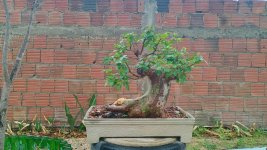trigo
Mame
In Brazil, there are many native species rarely used for bonsai. I'm not talking about well-known ones like jabuticaba, pitanga, or Brazilian Rain Tree, but rather species that most Brazilians have never even heard of. One that caught my attention is Amburana cearensis.
Very few people have attempted to cultivate this species as a bonsai, and those who have, only started doing so recently (less than five years ago, as far as I know). There is little to no information on the best soil, techniques, or how far this species can develop as a bonsai. No studies have been conducted specifically for this purpose, and even the academic research on the species is scarce and lacks detail.
I’m looking for insights on how to seriously cultivate an unexplored and little-known species. Some key questions:
Very few people have attempted to cultivate this species as a bonsai, and those who have, only started doing so recently (less than five years ago, as far as I know). There is little to no information on the best soil, techniques, or how far this species can develop as a bonsai. No studies have been conducted specifically for this purpose, and even the academic research on the species is scarce and lacks detail.
I’m looking for insights on how to seriously cultivate an unexplored and little-known species. Some key questions:
- Propagation: Should I focus on growing from cuttings, germinating seeds, or collecting yamadori?
- Testing: What’s the best way to experiment with different soil compositions and fertilizers?
- Techniques: How can I determine the most effective bonsai techniques for this species?
- Sample Size: How many plants would I need to grow to obtain reliable conclusions?
- Excellent wound healing, possibly better than Ficus.
- Can withstand radical root pruning.
- Allows very thick cuttings, similar to olive trees.
- Leaves reduce well in size.
- Beautiful trunk with multiple colors and natural peeling.
- Fragrant flowers and fruit production.
- Highly resistant to adverse conditions.
















